Safety and Risk Management: Analysis of the Granville Train Accident
VerifiedAdded on 2023/06/07
|10
|2054
|482
Report
AI Summary
This report provides a comprehensive analysis of the Granville train disaster, focusing on the safety breaches that contributed to the accident. It begins with an executive summary and an introduction, setting the stage for a detailed examination of the accident, including its causes, which are attributed to the poor condition of the permanent way, faulty locomotive maintenance, and bridge design flaws. The report details the safety breaches, such as the failure to maintain the locomotive and the structural inadequacies of the bridge. It then delves into the policies in place at the time and how the disaster exposed inadequacies in the New South Wales railway system. The report also recommends several measures to prevent similar accidents in the future, including improved track maintenance, locomotive safety checks, and enhanced safety protocols. The report concludes by emphasizing the importance of learning from the disaster to improve railway safety standards. This report, contributed by a student, is available on Desklib, a platform providing AI-based study tools for students.
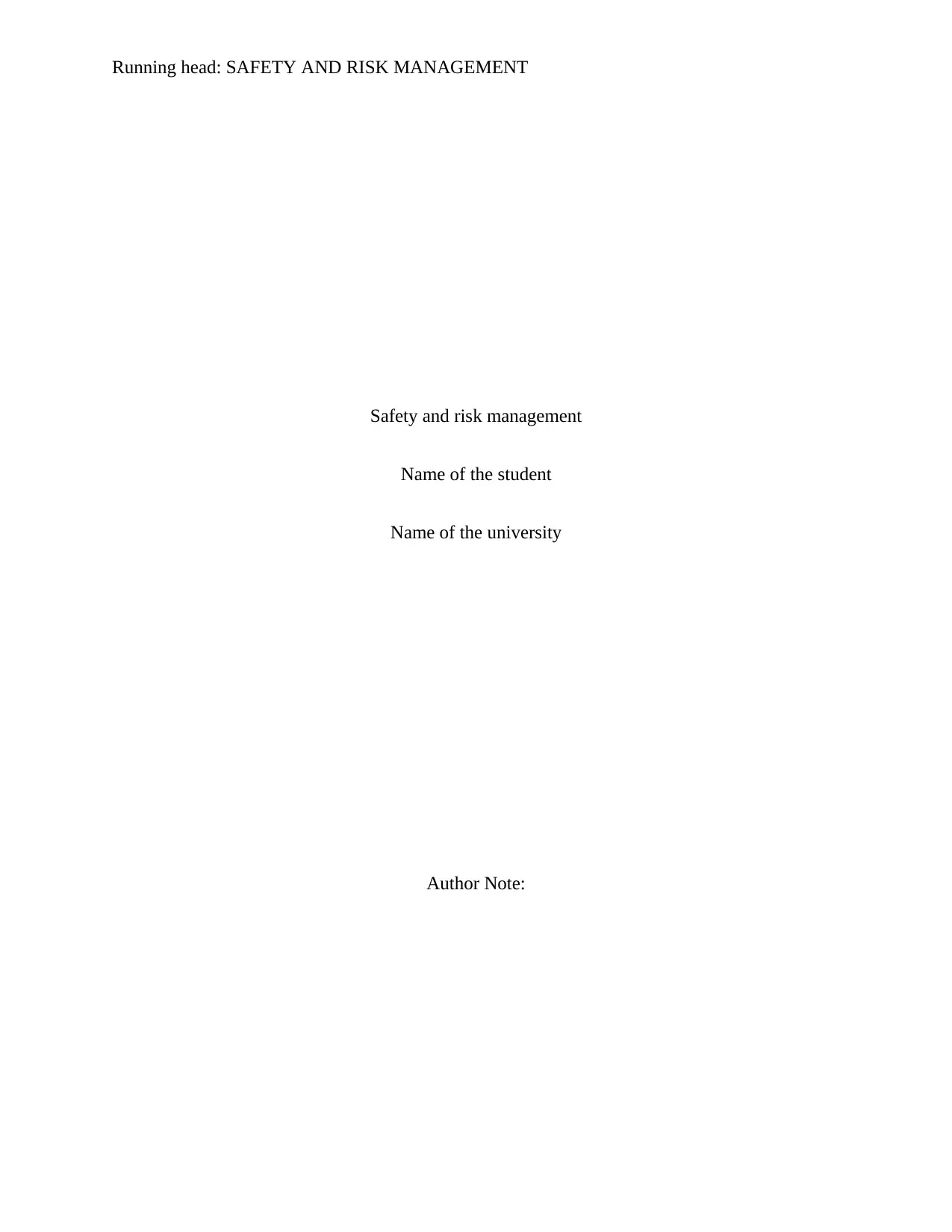
Running head: SAFETY AND RISK MANAGEMENT
Safety and risk management
Name of the student
Name of the university
Author Note:
Safety and risk management
Name of the student
Name of the university
Author Note:
Paraphrase This Document
Need a fresh take? Get an instant paraphrase of this document with our AI Paraphraser
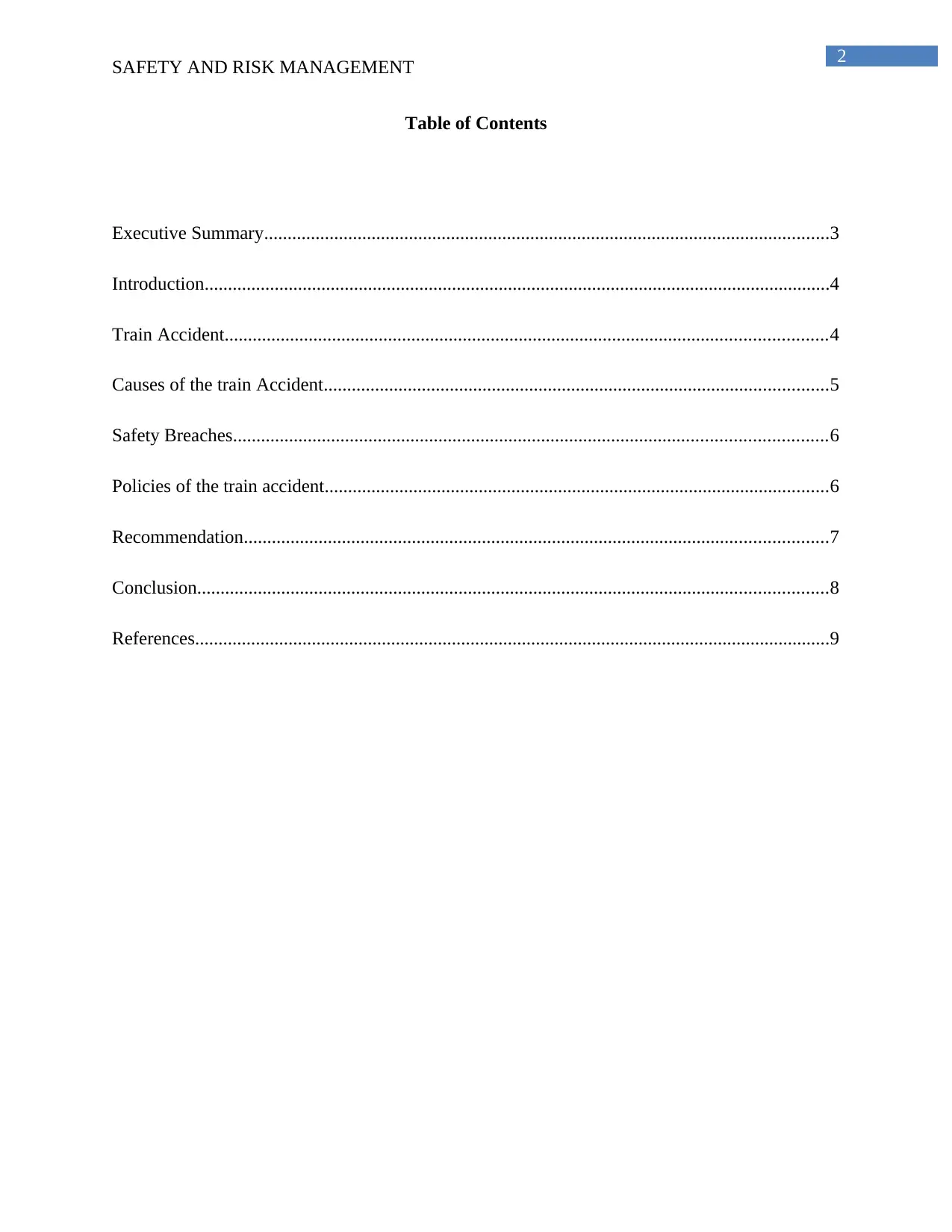
2
SAFETY AND RISK MANAGEMENT
Table of Contents
Executive Summary.........................................................................................................................3
Introduction......................................................................................................................................4
Train Accident.................................................................................................................................4
Causes of the train Accident............................................................................................................5
Safety Breaches...............................................................................................................................6
Policies of the train accident............................................................................................................6
Recommendation.............................................................................................................................7
Conclusion.......................................................................................................................................8
References........................................................................................................................................9
SAFETY AND RISK MANAGEMENT
Table of Contents
Executive Summary.........................................................................................................................3
Introduction......................................................................................................................................4
Train Accident.................................................................................................................................4
Causes of the train Accident............................................................................................................5
Safety Breaches...............................................................................................................................6
Policies of the train accident............................................................................................................6
Recommendation.............................................................................................................................7
Conclusion.......................................................................................................................................8
References........................................................................................................................................9
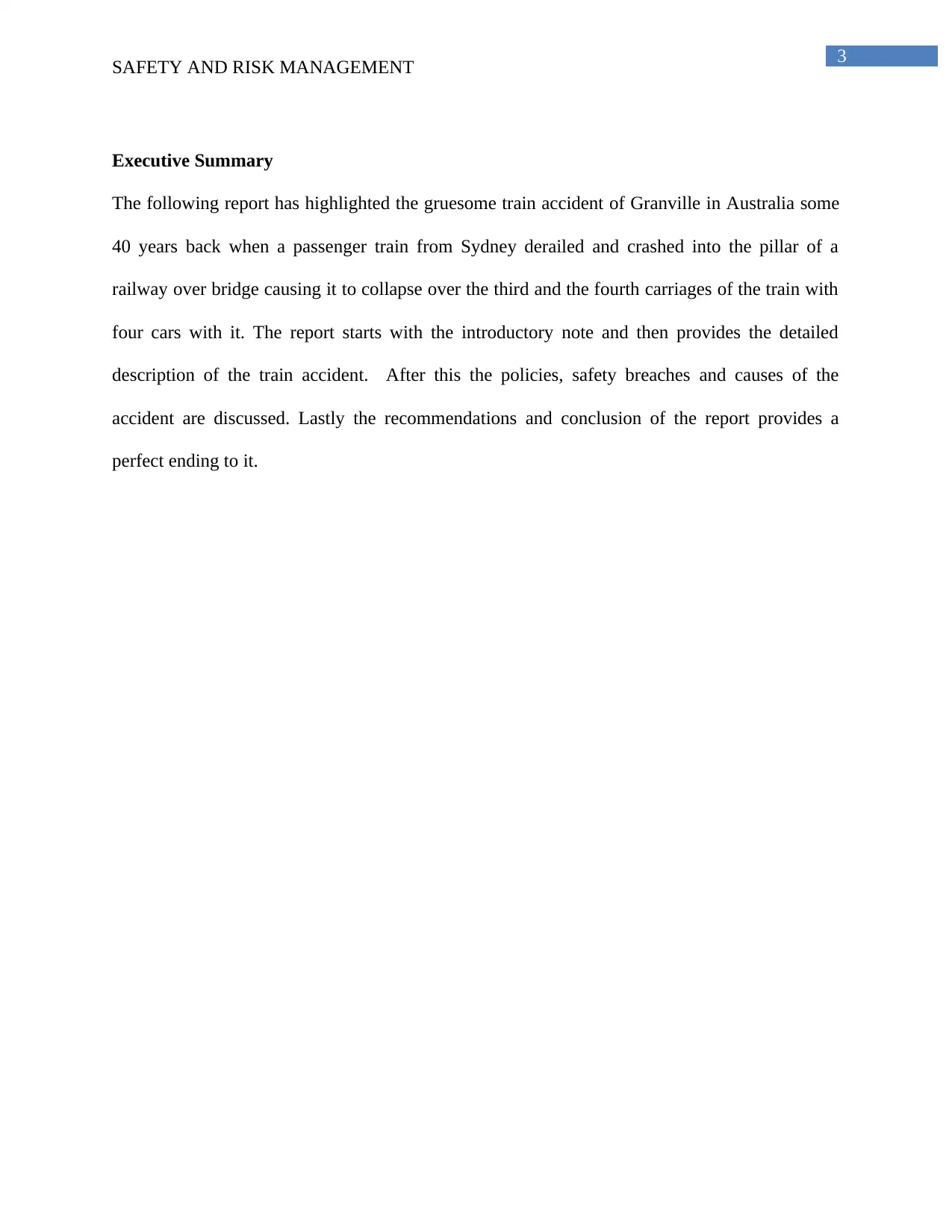
3
SAFETY AND RISK MANAGEMENT
Executive Summary
The following report has highlighted the gruesome train accident of Granville in Australia some
40 years back when a passenger train from Sydney derailed and crashed into the pillar of a
railway over bridge causing it to collapse over the third and the fourth carriages of the train with
four cars with it. The report starts with the introductory note and then provides the detailed
description of the train accident. After this the policies, safety breaches and causes of the
accident are discussed. Lastly the recommendations and conclusion of the report provides a
perfect ending to it.
SAFETY AND RISK MANAGEMENT
Executive Summary
The following report has highlighted the gruesome train accident of Granville in Australia some
40 years back when a passenger train from Sydney derailed and crashed into the pillar of a
railway over bridge causing it to collapse over the third and the fourth carriages of the train with
four cars with it. The report starts with the introductory note and then provides the detailed
description of the train accident. After this the policies, safety breaches and causes of the
accident are discussed. Lastly the recommendations and conclusion of the report provides a
perfect ending to it.
⊘ This is a preview!⊘
Do you want full access?
Subscribe today to unlock all pages.

Trusted by 1+ million students worldwide
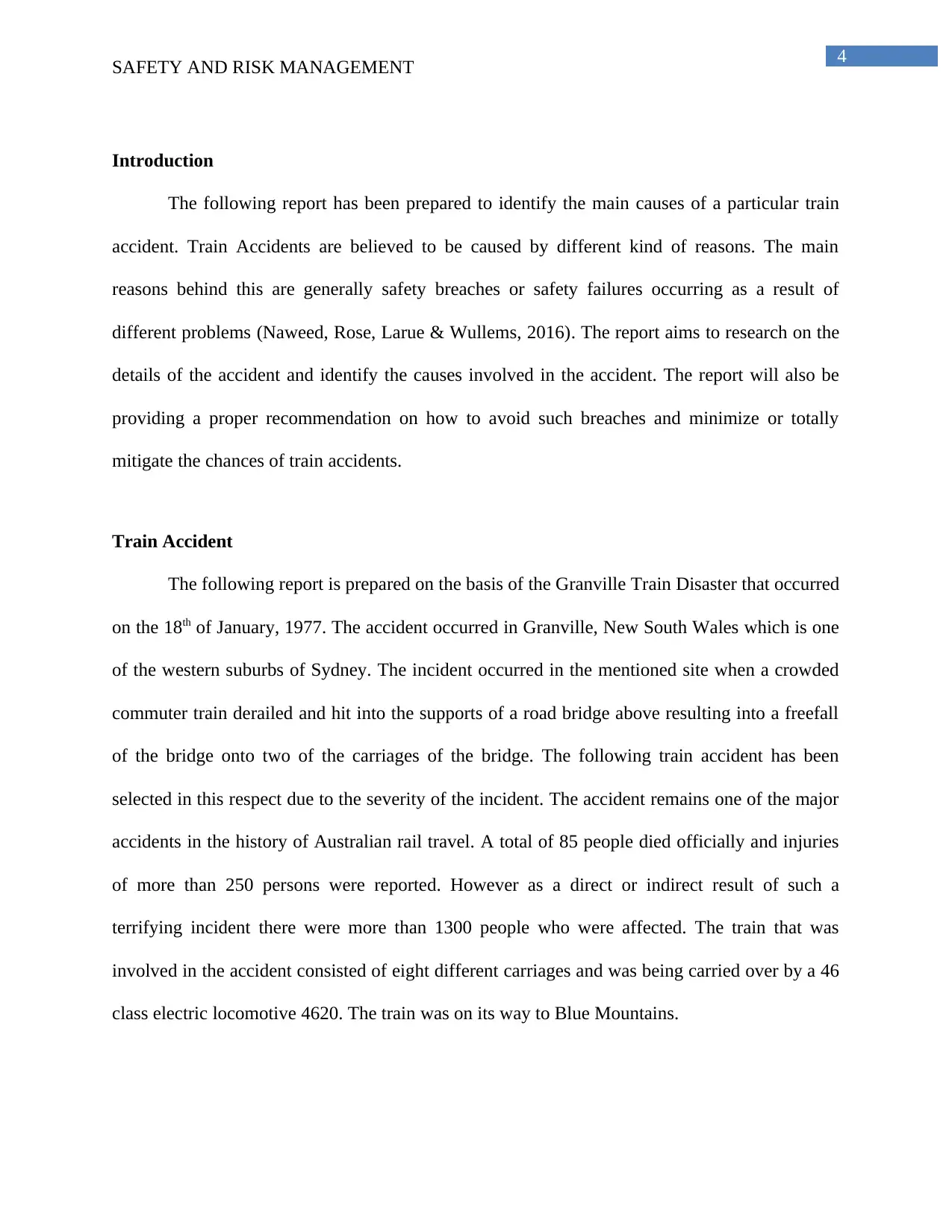
4
SAFETY AND RISK MANAGEMENT
Introduction
The following report has been prepared to identify the main causes of a particular train
accident. Train Accidents are believed to be caused by different kind of reasons. The main
reasons behind this are generally safety breaches or safety failures occurring as a result of
different problems (Naweed, Rose, Larue & Wullems, 2016). The report aims to research on the
details of the accident and identify the causes involved in the accident. The report will also be
providing a proper recommendation on how to avoid such breaches and minimize or totally
mitigate the chances of train accidents.
Train Accident
The following report is prepared on the basis of the Granville Train Disaster that occurred
on the 18th of January, 1977. The accident occurred in Granville, New South Wales which is one
of the western suburbs of Sydney. The incident occurred in the mentioned site when a crowded
commuter train derailed and hit into the supports of a road bridge above resulting into a freefall
of the bridge onto two of the carriages of the bridge. The following train accident has been
selected in this respect due to the severity of the incident. The accident remains one of the major
accidents in the history of Australian rail travel. A total of 85 people died officially and injuries
of more than 250 persons were reported. However as a direct or indirect result of such a
terrifying incident there were more than 1300 people who were affected. The train that was
involved in the accident consisted of eight different carriages and was being carried over by a 46
class electric locomotive 4620. The train was on its way to Blue Mountains.
SAFETY AND RISK MANAGEMENT
Introduction
The following report has been prepared to identify the main causes of a particular train
accident. Train Accidents are believed to be caused by different kind of reasons. The main
reasons behind this are generally safety breaches or safety failures occurring as a result of
different problems (Naweed, Rose, Larue & Wullems, 2016). The report aims to research on the
details of the accident and identify the causes involved in the accident. The report will also be
providing a proper recommendation on how to avoid such breaches and minimize or totally
mitigate the chances of train accidents.
Train Accident
The following report is prepared on the basis of the Granville Train Disaster that occurred
on the 18th of January, 1977. The accident occurred in Granville, New South Wales which is one
of the western suburbs of Sydney. The incident occurred in the mentioned site when a crowded
commuter train derailed and hit into the supports of a road bridge above resulting into a freefall
of the bridge onto two of the carriages of the bridge. The following train accident has been
selected in this respect due to the severity of the incident. The accident remains one of the major
accidents in the history of Australian rail travel. A total of 85 people died officially and injuries
of more than 250 persons were reported. However as a direct or indirect result of such a
terrifying incident there were more than 1300 people who were affected. The train that was
involved in the accident consisted of eight different carriages and was being carried over by a 46
class electric locomotive 4620. The train was on its way to Blue Mountains.
Paraphrase This Document
Need a fresh take? Get an instant paraphrase of this document with our AI Paraphraser
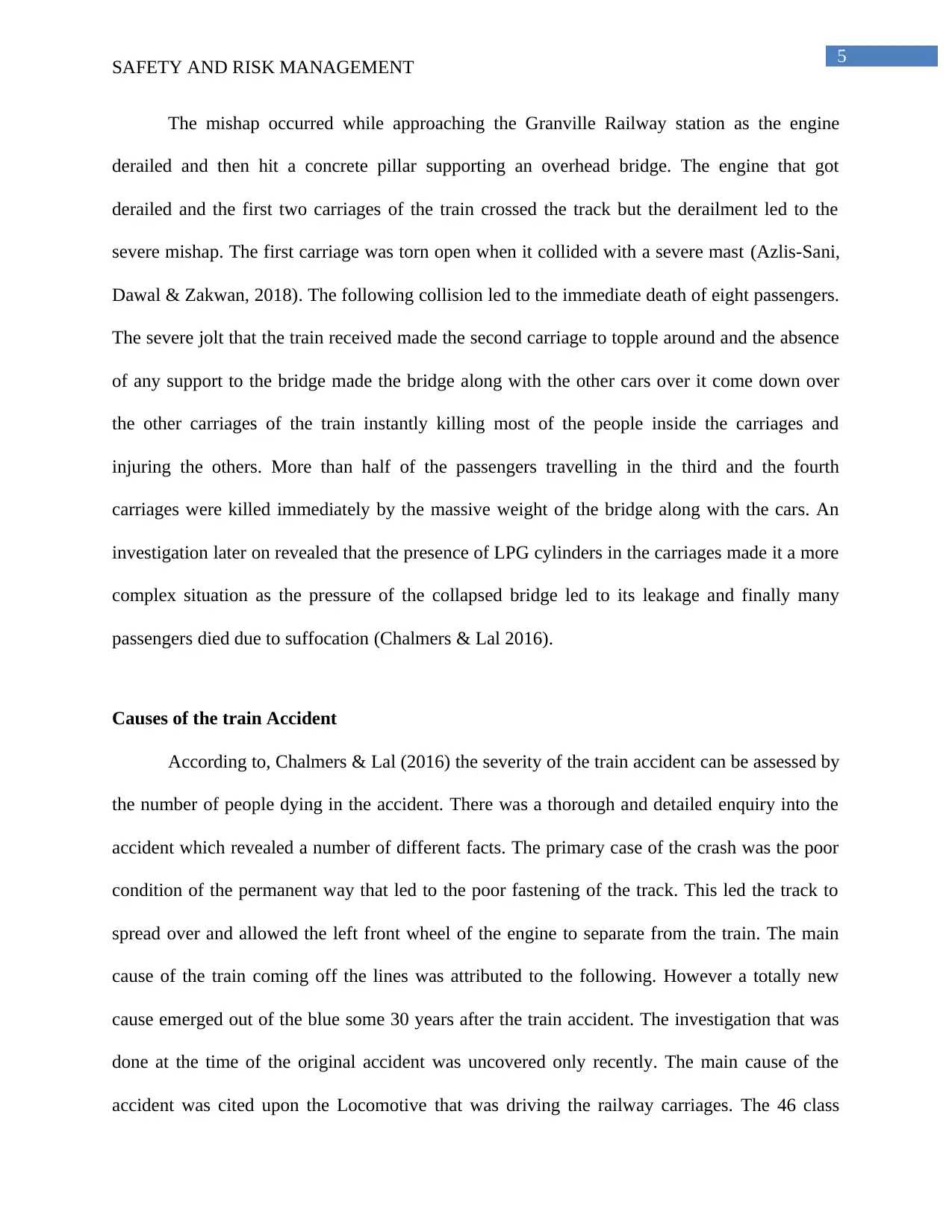
5
SAFETY AND RISK MANAGEMENT
The mishap occurred while approaching the Granville Railway station as the engine
derailed and then hit a concrete pillar supporting an overhead bridge. The engine that got
derailed and the first two carriages of the train crossed the track but the derailment led to the
severe mishap. The first carriage was torn open when it collided with a severe mast (Azlis-Sani,
Dawal & Zakwan, 2018). The following collision led to the immediate death of eight passengers.
The severe jolt that the train received made the second carriage to topple around and the absence
of any support to the bridge made the bridge along with the other cars over it come down over
the other carriages of the train instantly killing most of the people inside the carriages and
injuring the others. More than half of the passengers travelling in the third and the fourth
carriages were killed immediately by the massive weight of the bridge along with the cars. An
investigation later on revealed that the presence of LPG cylinders in the carriages made it a more
complex situation as the pressure of the collapsed bridge led to its leakage and finally many
passengers died due to suffocation (Chalmers & Lal 2016).
Causes of the train Accident
According to, Chalmers & Lal (2016) the severity of the train accident can be assessed by
the number of people dying in the accident. There was a thorough and detailed enquiry into the
accident which revealed a number of different facts. The primary case of the crash was the poor
condition of the permanent way that led to the poor fastening of the track. This led the track to
spread over and allowed the left front wheel of the engine to separate from the train. The main
cause of the train coming off the lines was attributed to the following. However a totally new
cause emerged out of the blue some 30 years after the train accident. The investigation that was
done at the time of the original accident was uncovered only recently. The main cause of the
accident was cited upon the Locomotive that was driving the railway carriages. The 46 class
SAFETY AND RISK MANAGEMENT
The mishap occurred while approaching the Granville Railway station as the engine
derailed and then hit a concrete pillar supporting an overhead bridge. The engine that got
derailed and the first two carriages of the train crossed the track but the derailment led to the
severe mishap. The first carriage was torn open when it collided with a severe mast (Azlis-Sani,
Dawal & Zakwan, 2018). The following collision led to the immediate death of eight passengers.
The severe jolt that the train received made the second carriage to topple around and the absence
of any support to the bridge made the bridge along with the other cars over it come down over
the other carriages of the train instantly killing most of the people inside the carriages and
injuring the others. More than half of the passengers travelling in the third and the fourth
carriages were killed immediately by the massive weight of the bridge along with the cars. An
investigation later on revealed that the presence of LPG cylinders in the carriages made it a more
complex situation as the pressure of the collapsed bridge led to its leakage and finally many
passengers died due to suffocation (Chalmers & Lal 2016).
Causes of the train Accident
According to, Chalmers & Lal (2016) the severity of the train accident can be assessed by
the number of people dying in the accident. There was a thorough and detailed enquiry into the
accident which revealed a number of different facts. The primary case of the crash was the poor
condition of the permanent way that led to the poor fastening of the track. This led the track to
spread over and allowed the left front wheel of the engine to separate from the train. The main
cause of the train coming off the lines was attributed to the following. However a totally new
cause emerged out of the blue some 30 years after the train accident. The investigation that was
done at the time of the original accident was uncovered only recently. The main cause of the
accident was cited upon the Locomotive that was driving the railway carriages. The 46 class
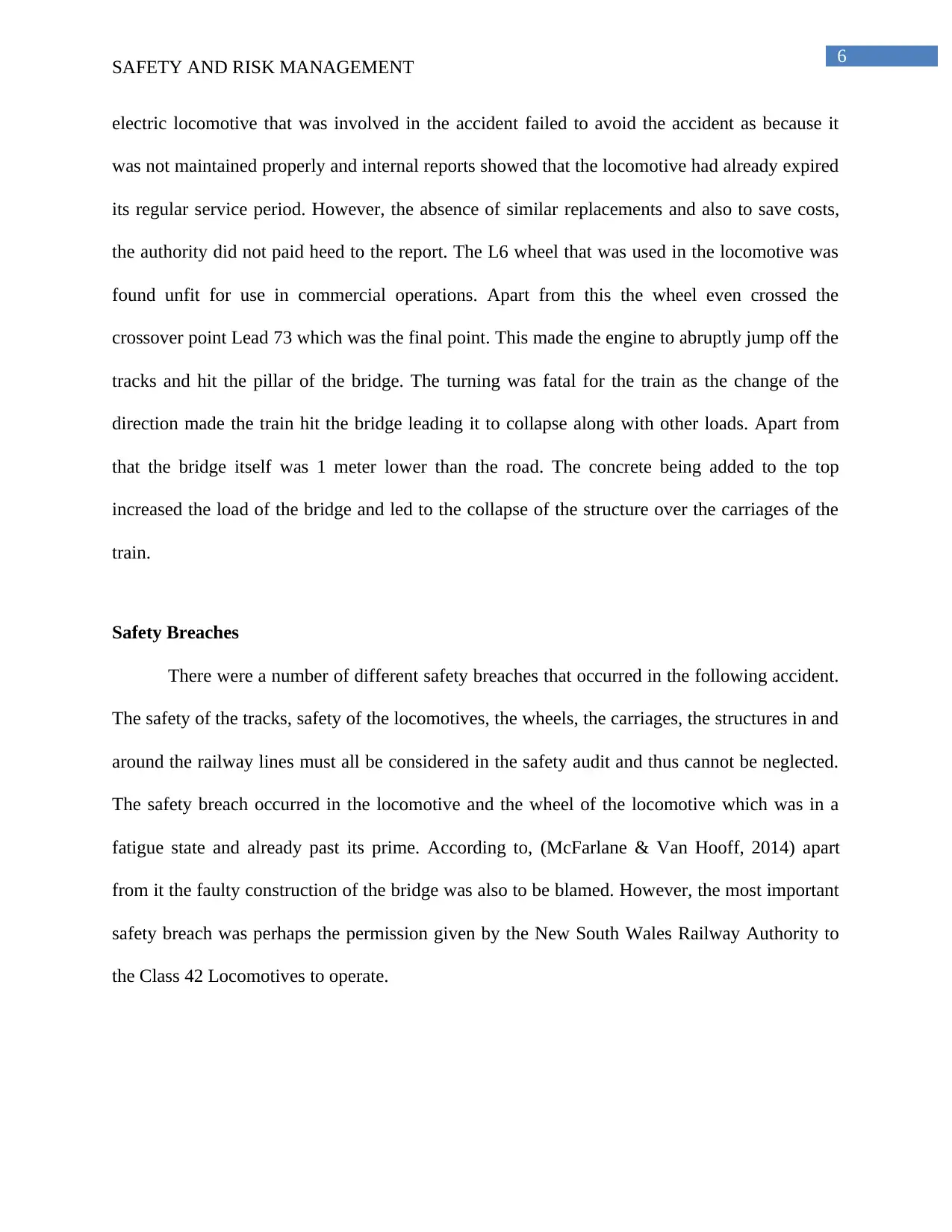
6
SAFETY AND RISK MANAGEMENT
electric locomotive that was involved in the accident failed to avoid the accident as because it
was not maintained properly and internal reports showed that the locomotive had already expired
its regular service period. However, the absence of similar replacements and also to save costs,
the authority did not paid heed to the report. The L6 wheel that was used in the locomotive was
found unfit for use in commercial operations. Apart from this the wheel even crossed the
crossover point Lead 73 which was the final point. This made the engine to abruptly jump off the
tracks and hit the pillar of the bridge. The turning was fatal for the train as the change of the
direction made the train hit the bridge leading it to collapse along with other loads. Apart from
that the bridge itself was 1 meter lower than the road. The concrete being added to the top
increased the load of the bridge and led to the collapse of the structure over the carriages of the
train.
Safety Breaches
There were a number of different safety breaches that occurred in the following accident.
The safety of the tracks, safety of the locomotives, the wheels, the carriages, the structures in and
around the railway lines must all be considered in the safety audit and thus cannot be neglected.
The safety breach occurred in the locomotive and the wheel of the locomotive which was in a
fatigue state and already past its prime. According to, (McFarlane & Van Hooff, 2014) apart
from it the faulty construction of the bridge was also to be blamed. However, the most important
safety breach was perhaps the permission given by the New South Wales Railway Authority to
the Class 42 Locomotives to operate.
SAFETY AND RISK MANAGEMENT
electric locomotive that was involved in the accident failed to avoid the accident as because it
was not maintained properly and internal reports showed that the locomotive had already expired
its regular service period. However, the absence of similar replacements and also to save costs,
the authority did not paid heed to the report. The L6 wheel that was used in the locomotive was
found unfit for use in commercial operations. Apart from this the wheel even crossed the
crossover point Lead 73 which was the final point. This made the engine to abruptly jump off the
tracks and hit the pillar of the bridge. The turning was fatal for the train as the change of the
direction made the train hit the bridge leading it to collapse along with other loads. Apart from
that the bridge itself was 1 meter lower than the road. The concrete being added to the top
increased the load of the bridge and led to the collapse of the structure over the carriages of the
train.
Safety Breaches
There were a number of different safety breaches that occurred in the following accident.
The safety of the tracks, safety of the locomotives, the wheels, the carriages, the structures in and
around the railway lines must all be considered in the safety audit and thus cannot be neglected.
The safety breach occurred in the locomotive and the wheel of the locomotive which was in a
fatigue state and already past its prime. According to, (McFarlane & Van Hooff, 2014) apart
from it the faulty construction of the bridge was also to be blamed. However, the most important
safety breach was perhaps the permission given by the New South Wales Railway Authority to
the Class 42 Locomotives to operate.
⊘ This is a preview!⊘
Do you want full access?
Subscribe today to unlock all pages.

Trusted by 1+ million students worldwide
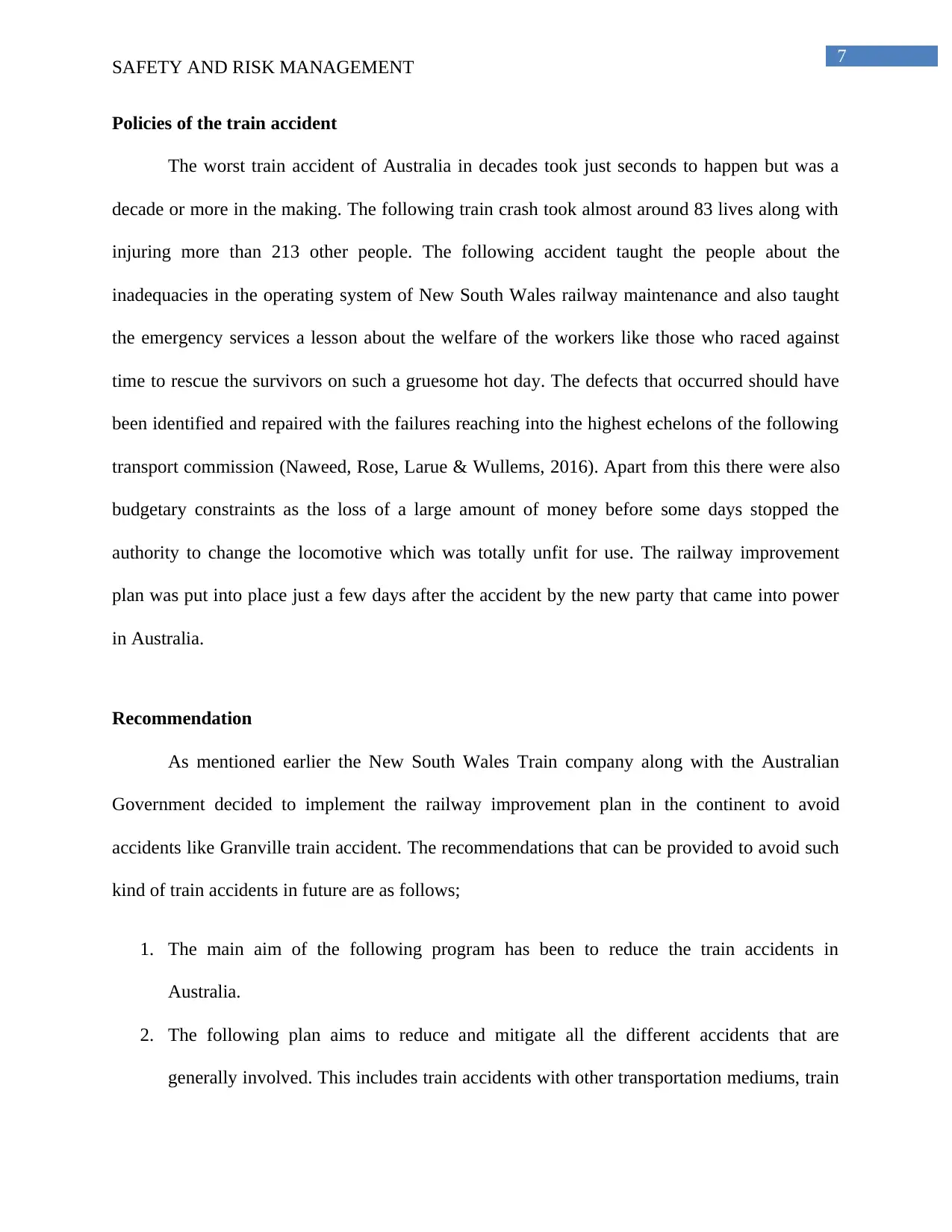
7
SAFETY AND RISK MANAGEMENT
Policies of the train accident
The worst train accident of Australia in decades took just seconds to happen but was a
decade or more in the making. The following train crash took almost around 83 lives along with
injuring more than 213 other people. The following accident taught the people about the
inadequacies in the operating system of New South Wales railway maintenance and also taught
the emergency services a lesson about the welfare of the workers like those who raced against
time to rescue the survivors on such a gruesome hot day. The defects that occurred should have
been identified and repaired with the failures reaching into the highest echelons of the following
transport commission (Naweed, Rose, Larue & Wullems, 2016). Apart from this there were also
budgetary constraints as the loss of a large amount of money before some days stopped the
authority to change the locomotive which was totally unfit for use. The railway improvement
plan was put into place just a few days after the accident by the new party that came into power
in Australia.
Recommendation
As mentioned earlier the New South Wales Train company along with the Australian
Government decided to implement the railway improvement plan in the continent to avoid
accidents like Granville train accident. The recommendations that can be provided to avoid such
kind of train accidents in future are as follows;
1. The main aim of the following program has been to reduce the train accidents in
Australia.
2. The following plan aims to reduce and mitigate all the different accidents that are
generally involved. This includes train accidents with other transportation mediums, train
SAFETY AND RISK MANAGEMENT
Policies of the train accident
The worst train accident of Australia in decades took just seconds to happen but was a
decade or more in the making. The following train crash took almost around 83 lives along with
injuring more than 213 other people. The following accident taught the people about the
inadequacies in the operating system of New South Wales railway maintenance and also taught
the emergency services a lesson about the welfare of the workers like those who raced against
time to rescue the survivors on such a gruesome hot day. The defects that occurred should have
been identified and repaired with the failures reaching into the highest echelons of the following
transport commission (Naweed, Rose, Larue & Wullems, 2016). Apart from this there were also
budgetary constraints as the loss of a large amount of money before some days stopped the
authority to change the locomotive which was totally unfit for use. The railway improvement
plan was put into place just a few days after the accident by the new party that came into power
in Australia.
Recommendation
As mentioned earlier the New South Wales Train company along with the Australian
Government decided to implement the railway improvement plan in the continent to avoid
accidents like Granville train accident. The recommendations that can be provided to avoid such
kind of train accidents in future are as follows;
1. The main aim of the following program has been to reduce the train accidents in
Australia.
2. The following plan aims to reduce and mitigate all the different accidents that are
generally involved. This includes train accidents with other transportation mediums, train
Paraphrase This Document
Need a fresh take? Get an instant paraphrase of this document with our AI Paraphraser
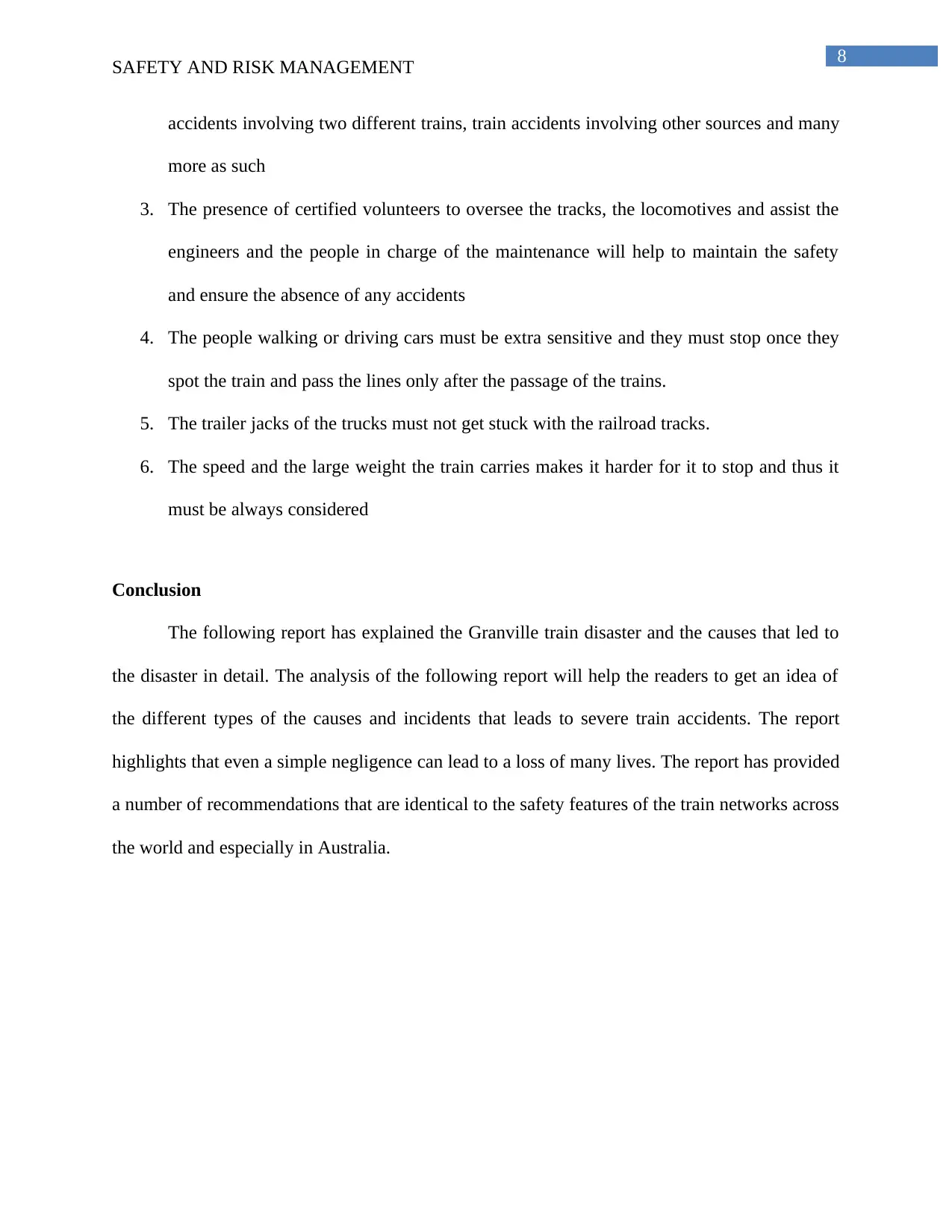
8
SAFETY AND RISK MANAGEMENT
accidents involving two different trains, train accidents involving other sources and many
more as such
3. The presence of certified volunteers to oversee the tracks, the locomotives and assist the
engineers and the people in charge of the maintenance will help to maintain the safety
and ensure the absence of any accidents
4. The people walking or driving cars must be extra sensitive and they must stop once they
spot the train and pass the lines only after the passage of the trains.
5. The trailer jacks of the trucks must not get stuck with the railroad tracks.
6. The speed and the large weight the train carries makes it harder for it to stop and thus it
must be always considered
Conclusion
The following report has explained the Granville train disaster and the causes that led to
the disaster in detail. The analysis of the following report will help the readers to get an idea of
the different types of the causes and incidents that leads to severe train accidents. The report
highlights that even a simple negligence can lead to a loss of many lives. The report has provided
a number of recommendations that are identical to the safety features of the train networks across
the world and especially in Australia.
SAFETY AND RISK MANAGEMENT
accidents involving two different trains, train accidents involving other sources and many
more as such
3. The presence of certified volunteers to oversee the tracks, the locomotives and assist the
engineers and the people in charge of the maintenance will help to maintain the safety
and ensure the absence of any accidents
4. The people walking or driving cars must be extra sensitive and they must stop once they
spot the train and pass the lines only after the passage of the trains.
5. The trailer jacks of the trucks must not get stuck with the railroad tracks.
6. The speed and the large weight the train carries makes it harder for it to stop and thus it
must be always considered
Conclusion
The following report has explained the Granville train disaster and the causes that led to
the disaster in detail. The analysis of the following report will help the readers to get an idea of
the different types of the causes and incidents that leads to severe train accidents. The report
highlights that even a simple negligence can lead to a loss of many lives. The report has provided
a number of recommendations that are identical to the safety features of the train networks across
the world and especially in Australia.
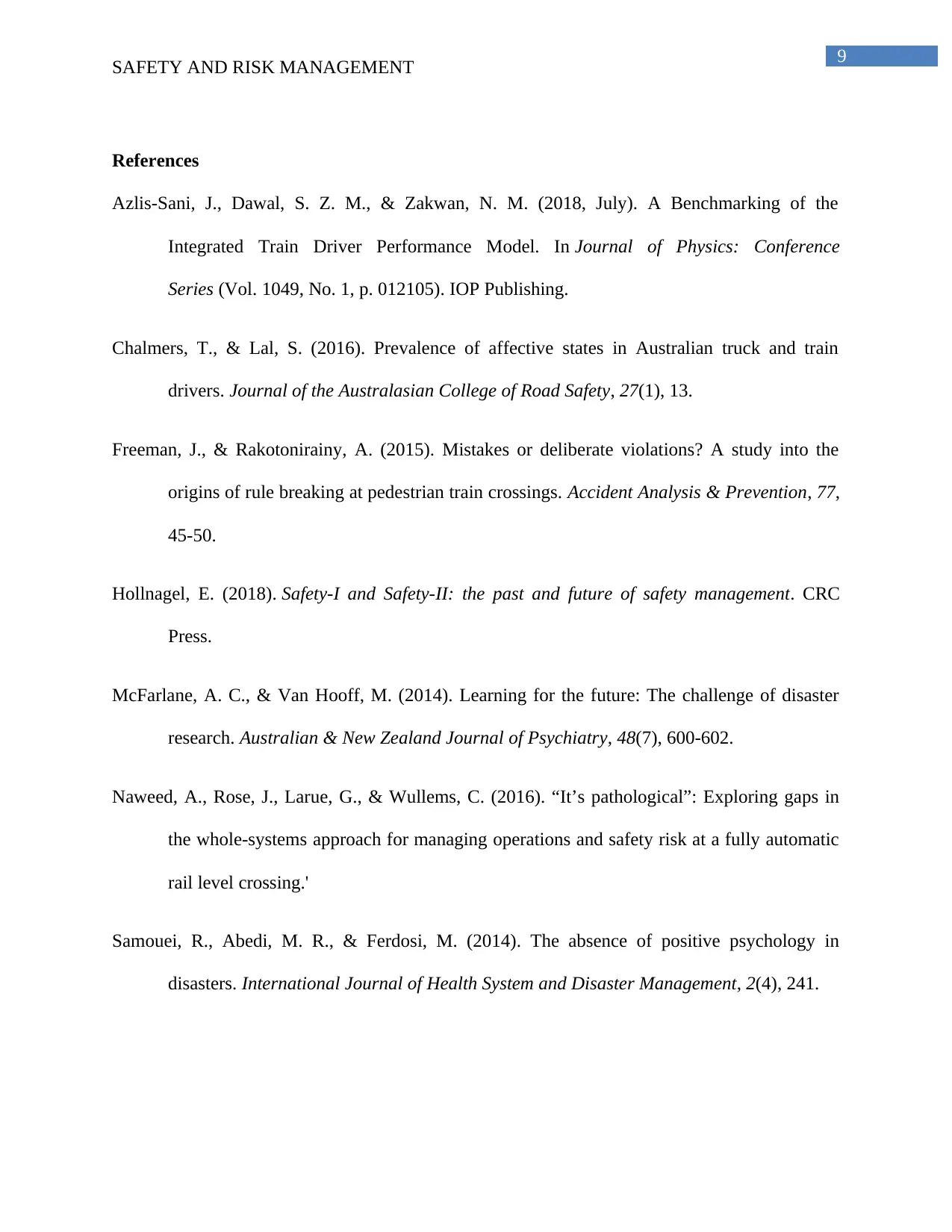
9
SAFETY AND RISK MANAGEMENT
References
Azlis-Sani, J., Dawal, S. Z. M., & Zakwan, N. M. (2018, July). A Benchmarking of the
Integrated Train Driver Performance Model. In Journal of Physics: Conference
Series (Vol. 1049, No. 1, p. 012105). IOP Publishing.
Chalmers, T., & Lal, S. (2016). Prevalence of affective states in Australian truck and train
drivers. Journal of the Australasian College of Road Safety, 27(1), 13.
Freeman, J., & Rakotonirainy, A. (2015). Mistakes or deliberate violations? A study into the
origins of rule breaking at pedestrian train crossings. Accident Analysis & Prevention, 77,
45-50.
Hollnagel, E. (2018). Safety-I and Safety-II: the past and future of safety management. CRC
Press.
McFarlane, A. C., & Van Hooff, M. (2014). Learning for the future: The challenge of disaster
research. Australian & New Zealand Journal of Psychiatry, 48(7), 600-602.
Naweed, A., Rose, J., Larue, G., & Wullems, C. (2016). “It’s pathological”: Exploring gaps in
the whole-systems approach for managing operations and safety risk at a fully automatic
rail level crossing.'
Samouei, R., Abedi, M. R., & Ferdosi, M. (2014). The absence of positive psychology in
disasters. International Journal of Health System and Disaster Management, 2(4), 241.
SAFETY AND RISK MANAGEMENT
References
Azlis-Sani, J., Dawal, S. Z. M., & Zakwan, N. M. (2018, July). A Benchmarking of the
Integrated Train Driver Performance Model. In Journal of Physics: Conference
Series (Vol. 1049, No. 1, p. 012105). IOP Publishing.
Chalmers, T., & Lal, S. (2016). Prevalence of affective states in Australian truck and train
drivers. Journal of the Australasian College of Road Safety, 27(1), 13.
Freeman, J., & Rakotonirainy, A. (2015). Mistakes or deliberate violations? A study into the
origins of rule breaking at pedestrian train crossings. Accident Analysis & Prevention, 77,
45-50.
Hollnagel, E. (2018). Safety-I and Safety-II: the past and future of safety management. CRC
Press.
McFarlane, A. C., & Van Hooff, M. (2014). Learning for the future: The challenge of disaster
research. Australian & New Zealand Journal of Psychiatry, 48(7), 600-602.
Naweed, A., Rose, J., Larue, G., & Wullems, C. (2016). “It’s pathological”: Exploring gaps in
the whole-systems approach for managing operations and safety risk at a fully automatic
rail level crossing.'
Samouei, R., Abedi, M. R., & Ferdosi, M. (2014). The absence of positive psychology in
disasters. International Journal of Health System and Disaster Management, 2(4), 241.
⊘ This is a preview!⊘
Do you want full access?
Subscribe today to unlock all pages.

Trusted by 1+ million students worldwide
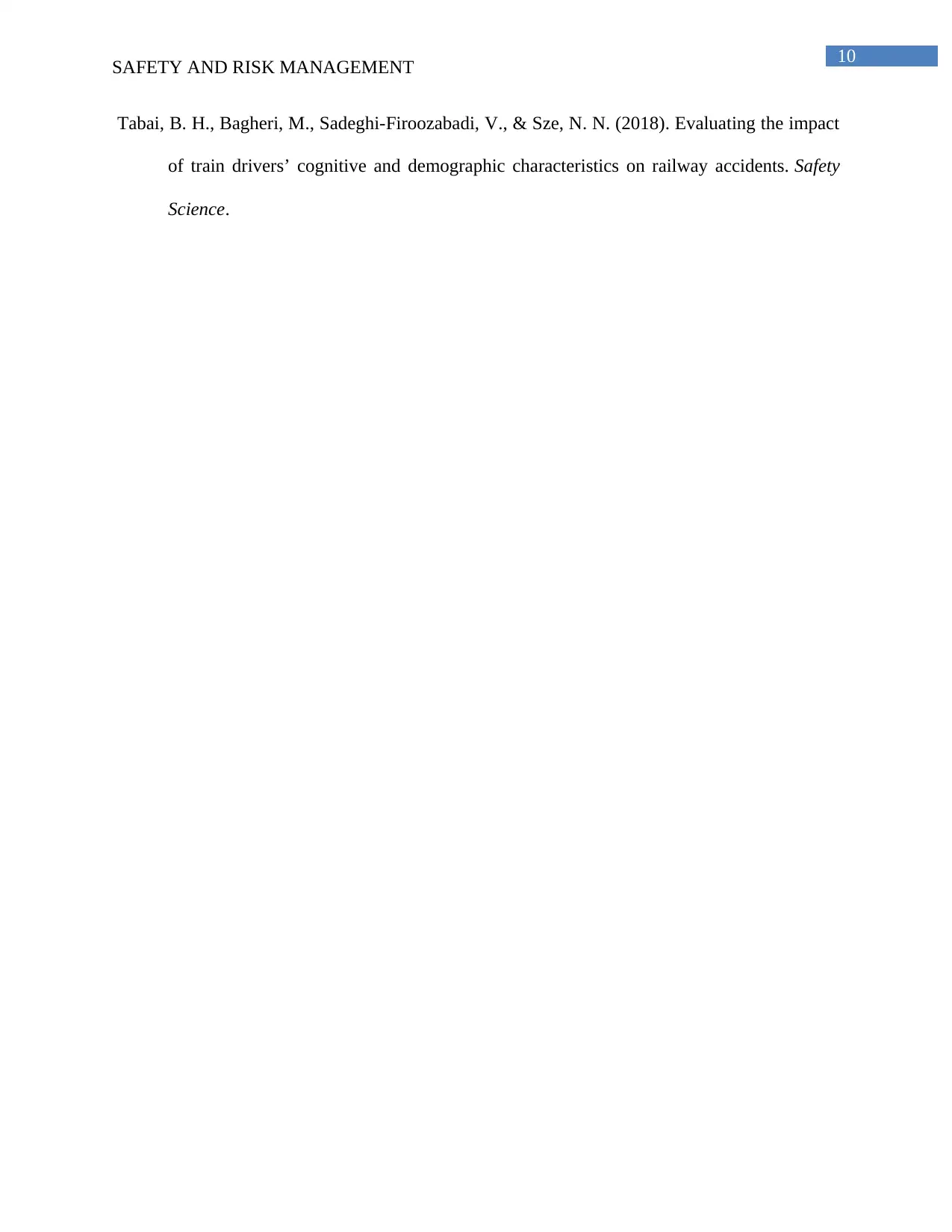
10
SAFETY AND RISK MANAGEMENT
Tabai, B. H., Bagheri, M., Sadeghi-Firoozabadi, V., & Sze, N. N. (2018). Evaluating the impact
of train drivers’ cognitive and demographic characteristics on railway accidents. Safety
Science.
SAFETY AND RISK MANAGEMENT
Tabai, B. H., Bagheri, M., Sadeghi-Firoozabadi, V., & Sze, N. N. (2018). Evaluating the impact
of train drivers’ cognitive and demographic characteristics on railway accidents. Safety
Science.
1 out of 10
Related Documents
Your All-in-One AI-Powered Toolkit for Academic Success.
+13062052269
info@desklib.com
Available 24*7 on WhatsApp / Email
![[object Object]](/_next/static/media/star-bottom.7253800d.svg)
Unlock your academic potential
Copyright © 2020–2025 A2Z Services. All Rights Reserved. Developed and managed by ZUCOL.





